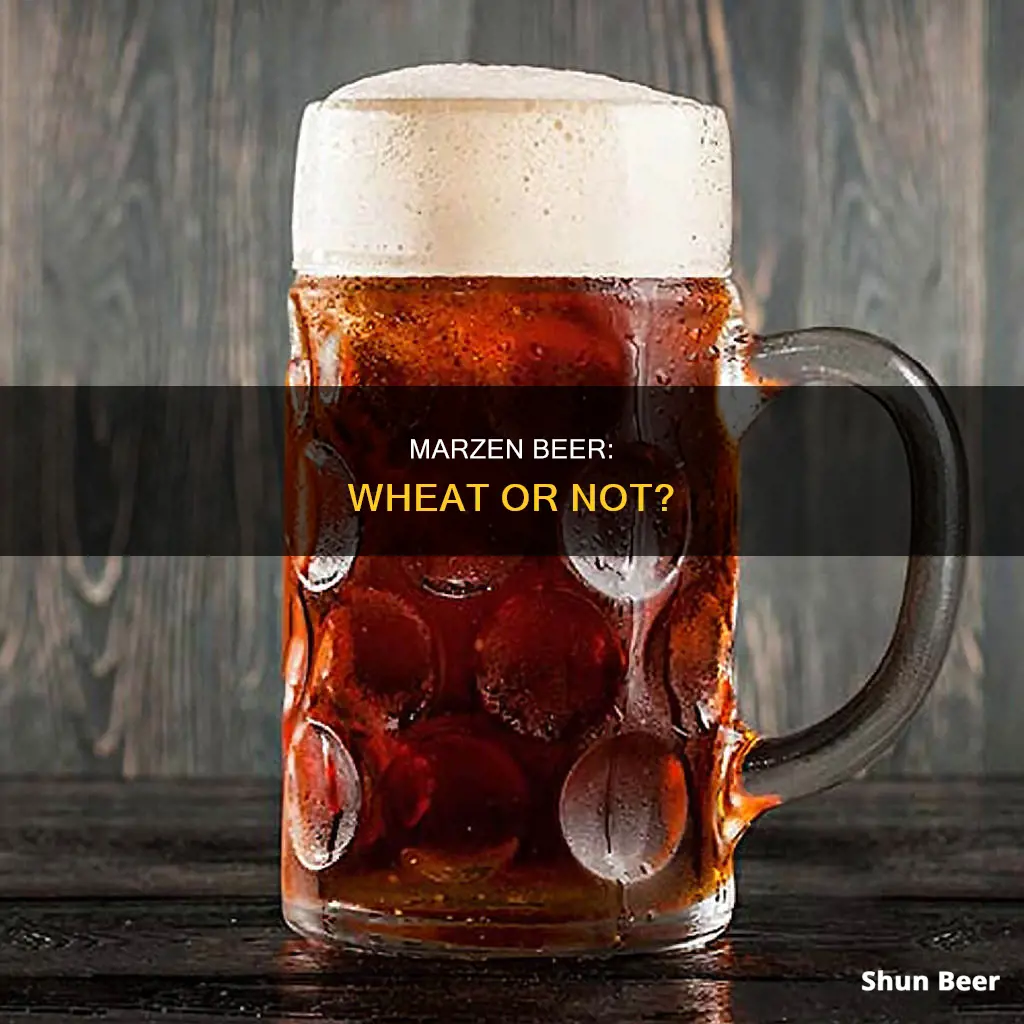
Märzen is a lager that originated in Bavaria, Germany, and is usually served at the Munich Oktoberfest. It is often brewed in March, which is where it gets its name from (Märzen meaning March in German). It has a medium to full body and its colour can vary from pale to dark brown. It is stronger than other beers, with a higher alcohol content, and is often described as having a malty, hoppy flavour. So, is it a wheat beer?
| Characteristics | Values |
|---|---|
| Type of Beer | Lager |
| Origin | Bavaria, Germany |
| Colour | Pale, Amber, Dark Brown |
| ABV | 5.1–6.0% |
| Body | Medium to Full |
| Flavour | Sweet, Less Hoppy |
| Fermentation | Bottom-Fermented |
| Malt | Toasted Bread or Biscuit-like |
| Bitterness | Balanced, Clean |
What You'll Learn
- Märzen is a lager with a medium to full body and varying colours
- It originated in Bavaria, Germany, and is traditionally served at Munich's Oktoberfest
- Märzen is brewed in March with higher alcohol content to last through the summer
- The original Märzen was described as dark brown, full-bodied, and bitter
- Märzen is now a rare beer in Germany, mainly found in the south

Märzen is a lager with a medium to full body and varying colours
The name Märzen means 'March beer' in German, as it was brewed in March and then allowed to lager in ice and straw-filled cellars until autumn. The original Märzen was described as "dark brown, full-bodied, and bitter". It was brewed with moderate and balanced hopping levels, malt and a slightly higher alcohol content to allow it to last through the summer months when brewing was forbidden due to high temperatures causing off-flavoured beer.
Today, Märzen is a rare beer in Germany, mainly found in the south of the country, and often associated with Oktoberfest. In Austria, Märzen is the most popular type of beer, but it is lighter in colour and taste, resembling a Bavarian Helles or Export beer. Märzen is also produced in the Czech Republic, Lithuania and Poland.
Compared to a Bavarian pale lager, Märzen is characterised by a fuller body and a sweeter, less hoppy flavour. It typically contains 5.1-6.0% alcohol by volume and is known for its malty, toasted bread or biscuit-like flavour.
Budweiser Beer: Wheat-Free or Not?
You may want to see also

It originated in Bavaria, Germany, and is traditionally served at Munich's Oktoberfest
Märzen, or Märzenbier in German, is a lager that originated in Bavaria, Germany. It is a medium to full-bodied beer that can vary in colour from pale to amber to dark brown. The name Märzen means 'March' in German, as the beer was traditionally brewed in March and then lagered in ice and straw-filled cellars until autumn.
A Bavarian brewing ordinance decreed in 1553 that beer could only be brewed between 29 September (St. Michael's Day) and 23 April (St. George's Day). Brewing was forbidden in the summer due to high temperatures, which could cause off-flavoured beer, and the lack of technology to control the fermentation process. To get around this, a stronger beer was brewed in March that would last through the summer and into the autumn festival season. This is how Märzen came to be served at Munich's Oktoberfest.
Oktoberfest is a festival that takes place in Munich, Bavaria, and Märzen has been an integral part of it. The geographical indication Oktoberfestbier is protected in the EU, and only beer brewed in Munich can be labelled as such. The original Märzen was described as "dark brown, full-bodied, and bitter", and it was often kept in the cellar until late summer before being served at Oktoberfest.
Today, Märzen is a rare beer in Germany, mainly found in the south of the country, and often in varieties that explicitly refer to its association with Oktoberfest. One example is the "Oktoberfest Bier" from the Paulaner brewery. However, the traditional Märzen style is characterised by a fuller body and a sweeter, less hoppy flavour compared to a Bavarian pale lager. It typically contains 5.1–6.0% alcohol by volume.
Wheat in Sapporo Beer: What You Need to Know
You may want to see also

Märzen is brewed in March with higher alcohol content to last through the summer
Märzen, or "March beer" in German, is a lager that originated in Bavaria, Germany. It is typically brewed in March with a higher alcohol content and moderate and balanced hopping levels to allow it to last through the summer, when brewing was forbidden due to high temperatures causing off-flavoured beer.
Before the invention of refrigeration, Bavarian brewers could only brew beer during the colder months of the year. The last brew of the year, typically in early spring (March), was crafted with a higher alcohol content and more hops, acting as preservatives. These brews were then stored in caves or "lagered" and gradually consumed through the summer.
The Märzen style of beer has a medium to full body and can vary in colour from pale to amber to dark brown. The original Märzen was described as "dark brown, full-bodied, and bitter". It was often kept in cellars until late summer and served at the Munich Oktoberfest in autumn.
The higher alcohol content of Märzen, typically ranging from 5.1% to 6.0% alcohol by volume, contributed to its longevity and made it suitable for consumption during the warmer months. This brewing technique ensured that people could enjoy beer during the summer, even when brewing was not possible due to the lack of refrigeration and the risk of fires caused by the simmering process.
The Märzen style of beer is characterised by its fuller body, sweeter flavour, and moderate bitterness. It has a clean, deep malty richness with notes of toast and bread, and no caramel or roasted aromas. The higher alcohol content, balanced hopping levels, and storage in ice-filled cellars during the summer months ensured that Märzen remained fresh and flavourful until it was served at Oktoberfest celebrations.
IPAs and Wheat Beers: What's the Connection?
You may want to see also

The original Märzen was described as dark brown, full-bodied, and bitter
Märzen, or Märzenbier in German, is a lager that originated in Bavaria, Germany. It is a medium to full-bodied beer that ranges in colour from pale to amber to dark brown. The original Märzen was described as "dark brown, full-bodied, and bitter".
Märzen was traditionally brewed in March and was made to last through the summer until autumn. This was due to a Bavarian brewing ordinance that decreed beer could only be brewed between 29 September (St. Michael's Day) and 23 April (St. George's Day) to prevent off-flavoured beer caused by high summertime temperatures. The beer was then stored in ice and straw-filled cellars until autumn, when it was served at the Munich Oktoberfest.
The traditional Märzen style is characterised by a fuller body and a sweeter, less hoppy flavour than a Bavarian pale lager. It typically has an alcohol content of 5.1% to 6.0% by volume.
Today, Märzen is a rare beer in Germany, mainly found in the south of the country, and is often associated with Oktoberfest. However, in Austria, Märzen is the most popular type of beer and is lighter in colour and taste, resembling a Bavarian Helles or Export beer.
Wheat and Beer: What's the Connection?
You may want to see also

Märzen is now a rare beer in Germany, mainly found in the south
Märzen, or Märzenbier, is a German lager that originated in Bavaria, Germany. It is characterised by a medium to full body and varies in colour from pale to amber to dark brown. The name Märzen is German for 'March beer', as it was traditionally brewed in March and stored in caves or cellars until autumn, when it was served at harvest festivals.
In Germany, Märzen is now a rare beer, mainly found in the south of the country. It is often sold in varieties that explicitly refer to its association with Oktoberfest, such as the "Oktoberfest Bier" from the Paulaner brewery.
The reason for its rarity in Germany may be due in part to the arrival in 1953 of the light-coloured Augustiner “Edelstoff,” which knocked the traditionally amber-coloured Märzen off the top spot as the most popular Oktoberfest bier. All the Munich breweries followed suit, and Paulaner’s Oktoberfest Marzen Lager is now only brewed for drinkers outside of Germany, having been replaced by Oktoberfest Wiesn in its home country.
In Austria, Märzen is the most popular type of beer, but it is lighter in colour and taste and corresponds to a Bavarian Helles or Export beer. This is due to Austrian post-war regulations that limited the prices of food and drink products.
Sol Beer and Wheat: What's the Connection?
You may want to see also
Frequently asked questions
No, Marzen is a lager that originated in Bavaria, Germany. It is a full-bodied beer with a moderate to bitter taste and an alcohol content of around 5.1–6.0%.
Wheat beers are typically brewed at warmer temperatures than lagers, using top-fermenting yeast. This results in a faster fermentation process and a more complex flavor profile. Wheat beers are also known for their tangy, fruity, and crisp taste. Marzen, on the other hand, is a lager with a fuller body and a sweeter, less hoppy flavor.
Popular wheat beers include Hefeweizen, Dunkelweizen, and Weizenbock. Hefeweizen is the most common and is known for its cloudy appearance and banana and clove-like aromatics. Dunkelweizen is a darker variation with a caramelly, dark fruit-like flavor. Weizenbock is a stronger version with a more intense flavor profile.







